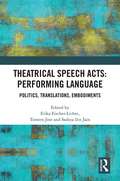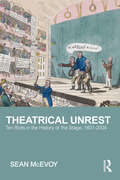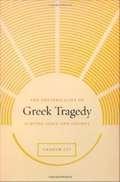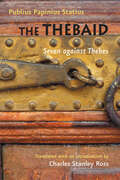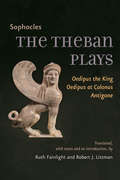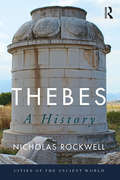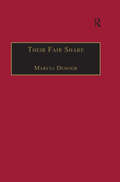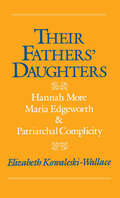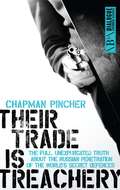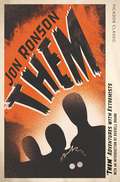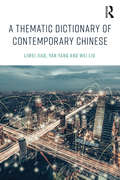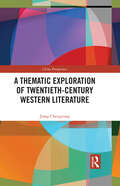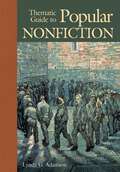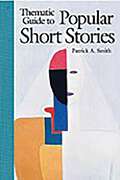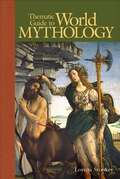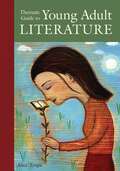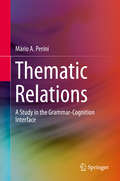- Table View
- List View
Theatrical Speech Acts: Politics, Translations, Embodiments
by Erika Fischer-Lichte Torsten Jost Saskya Iris JainTheatrical Speech Acts: Performing Language explores the significance and impact of words in performance, probing how language functions in theatrical scenarios, what it can achieve under particular conditions, and what kinds of problems may arise as a result. Presenting case studies from around the globe—spanning Argentina, Egypt, Germany, India, Indonesia, Korea, Kenya, Nigeria, Rwanda, Thailand, the UK and the US—the authors explore key issues related to theatrical speech acts, such as (post)colonial language politics; histories, practices and theories of translation for/in performance; as well as practices and processes of embodiment. With scholars from different cultural and disciplinary backgrounds examining theatrical speech acts—their preconditions, their cultural and bodily dimensions as well as their manifold political effects—the book introduces readers to a crucial linguistic dimension of historical and contemporary processes of interweaving performance cultures. Ideal for drama, theater, performance, and translation scholars worldwide, Theatrical Speech Acts opens up a unique perspective on the transformative power of language in performance.
Theatrical Unrest: Ten Riots in the History of the Stage, 1601-2004
by Sean McEvoyShortlisted for the 2017 Theatre Book Prize What is it about theatre, compared to other kinds of cultural representation, which provokes such a powerful reaction? Theatrical Unrest tells the compelling tales of ten riots whose cause lies on stage. It looks at the intensity and evanescence of the live event and asks whether theatre shares its unrepeatable quality with history. Tracing episodes of unrest in theatrical history from an Elizabethan uprising over Shakespeare's Richard II to Sikhs in revolt at Gurpreet Kaur Bhatti's Behzti, Sean McEvoy chronicles a selection of extreme public responses to this inflammatory art form. Each chapter provides a useful overview of the structure and documentation of one particular event, juxtaposing eyewitness accounts with newspaper reports and other contemporary narratives. Theatrical Unrest is an absorbing account of the explosive impact of performance, and an essential read for anyone interested in theatre’s often violent history.
Theatrical Unrest: Ten Riots in the History of the Stage, 1601-2004
by Sean McEvoyShortlisted for the 2017 Theatre Book Prize What is it about theatre, compared to other kinds of cultural representation, which provokes such a powerful reaction? Theatrical Unrest tells the compelling tales of ten riots whose cause lies on stage. It looks at the intensity and evanescence of the live event and asks whether theatre shares its unrepeatable quality with history. Tracing episodes of unrest in theatrical history from an Elizabethan uprising over Shakespeare's Richard II to Sikhs in revolt at Gurpreet Kaur Bhatti's Behzti, Sean McEvoy chronicles a selection of extreme public responses to this inflammatory art form. Each chapter provides a useful overview of the structure and documentation of one particular event, juxtaposing eyewitness accounts with newspaper reports and other contemporary narratives. Theatrical Unrest is an absorbing account of the explosive impact of performance, and an essential read for anyone interested in theatre’s often violent history.
The Theatricality of Greek Tragedy: Playing Space and Chorus
by Graham LeyAncient Greek tragedy has been an inspiration to Western culture, but the way it was first performed has long remained in question. In The Theatricality of Greek Tragedy, Graham Ley provides an illuminating discussion of key issues relating to the use of the playing space and the nature of the chorus, offering a distinctive impression of the performance of Greek tragedy in the fifth century BCE. Drawing on evidence from the surviving texts of tragedies by Aeschylus, Sophocles, and Euripides, Ley explains how scenes with actors were played in the open ground of the orchestra, often considered as exclusively the dancing place of the chorus. In reviewing what is known of the music and dance of Greek antiquity, Ley goes on to show that in the original productions the experience of the chorus—expressed in song and dance and in interaction with the characters—remained a vital characteristic in the performance of tragedy. Combining detailed analysis with broader reflections about the nature of ancient Greek tragedy as an art form, this volume—supplemented with a series of illustrative drawings and diagrams—will be a necessary addition to the bookshelf of anyone interested in literature, theater, or classical studies.
The Theatricality of Greek Tragedy: Playing Space and Chorus
by Graham LeyAncient Greek tragedy has been an inspiration to Western culture, but the way it was first performed has long remained in question. In The Theatricality of Greek Tragedy, Graham Ley provides an illuminating discussion of key issues relating to the use of the playing space and the nature of the chorus, offering a distinctive impression of the performance of Greek tragedy in the fifth century BCE. Drawing on evidence from the surviving texts of tragedies by Aeschylus, Sophocles, and Euripides, Ley explains how scenes with actors were played in the open ground of the orchestra, often considered as exclusively the dancing place of the chorus. In reviewing what is known of the music and dance of Greek antiquity, Ley goes on to show that in the original productions the experience of the chorus—expressed in song and dance and in interaction with the characters—remained a vital characteristic in the performance of tragedy. Combining detailed analysis with broader reflections about the nature of ancient Greek tragedy as an art form, this volume—supplemented with a series of illustrative drawings and diagrams—will be a necessary addition to the bookshelf of anyone interested in literature, theater, or classical studies.
The Theatricality of Greek Tragedy: Playing Space and Chorus
by Graham LeyAncient Greek tragedy has been an inspiration to Western culture, but the way it was first performed has long remained in question. In The Theatricality of Greek Tragedy, Graham Ley provides an illuminating discussion of key issues relating to the use of the playing space and the nature of the chorus, offering a distinctive impression of the performance of Greek tragedy in the fifth century BCE. Drawing on evidence from the surviving texts of tragedies by Aeschylus, Sophocles, and Euripides, Ley explains how scenes with actors were played in the open ground of the orchestra, often considered as exclusively the dancing place of the chorus. In reviewing what is known of the music and dance of Greek antiquity, Ley goes on to show that in the original productions the experience of the chorus—expressed in song and dance and in interaction with the characters—remained a vital characteristic in the performance of tragedy. Combining detailed analysis with broader reflections about the nature of ancient Greek tragedy as an art form, this volume—supplemented with a series of illustrative drawings and diagrams—will be a necessary addition to the bookshelf of anyone interested in literature, theater, or classical studies.
The Thebaid: Seven against Thebes (Johns Hopkins New Translations from Antiquity)
by Publius Papinius StatiusA classical epic of fratricide and war, the Thebaid retells the legendary conflict between the sons of Oedipus—Polynices and Eteocles—for control of the city of Thebes. The Latin poet Statius reworks a familiar story from Greek myth, dramatized long before by Aeschylus in his tragedy Seven against Thebes. Statius chose his subject well: the Rome of his day, ruled by the emperor Domitian, was not too distant from the civil wars that had threatened the survival of the empire. Published in 92 A.D., the Thebaid was an immediate success, and its fame grew in succeeding centuries. It reached its peak of popularity in the later Middle Ages and Renaissance, influencing Dante, Chaucer, and perhaps Shakespeare. In recent times, however, it has received perhaps less attention than it deserves, in large part because there has been no accessible, dynamic translation of the work into English.Charles Stanley Ross offers a compelling version of the Thebaid rendered into forceful, modern English. Casting Statius's Latin hexameter into a lively iambic pentameter more natural to the modern ear, Ross frees the work from the archaic formality that has marred previous translations. His translation reinvigorates the Thebaid as a whole: its meditative first half and its violent second half; its intimate portrayal of defeat and retribution, and the need to seek justice at any cost. In a wide-ranging introduction, Ross provides an overview of the poem: its composition, reception and legacy; its major themes and literary influences; and its place in Statius' life. And in a helpful series of notes, he offers background information on the major characters and incidents.
The Theban Plays: Oedipus the King, Oedipus at Colonus, Antigone (Johns Hopkins New Translations from Antiquity)
by SophoclesSophocles’ Theban Plays—Oedipus the King, Oedipus at Colonus, and Antigone—lie at the core of the Western literary canon. They are extensively translated, universally taught, and frequently performed. Chronicling the downfall of Oedipus, the legendary king of Thebes, and his descendants, the Theban Plays are as relevant to present-day thought about love, duty, patriotism, family, and war as when they were written 2,500 years ago.Recent translations of the plays, while linguistically correct, often fail to capture the beauty of Sophocles’ original words. In combining the skills of a distinguished poet, Ruth Fainlight, and an eminent classical scholar, Robert J. Littman, this new edition of the Theban Plays is both a major work of poetry and a faithful translation of the original works. Thoughtful introductions, extensive notes, and glossaries frame each of the plays within their historical contexts and illuminate important themes, mythological roots, and previous interpretations.This elegant and uncommonly readable translation will make these seminal Greek tragedies accessible to a new generation of readers.
The Theban Plays (Penguin Classics): (pdf)
by Sophocles E. F. Watling (Translator Introduction‘O Light! May I never look on you again, Revealed as I am, sinful in my begetting, Sinful in marriage, sinful in shedding of blood!’ The legends surrounding the royal house of Thebes inspired Sophocles (496–406 BC) to create a powerful trilogy of mankind’s struggle against fate. King Oedipus tells of a man who brings pestilence to Thebes for crimes he does not realise he has committed, and then inflicts a brutal punishment upon himself. With profound insights into the human condition, it is a devastating portrayal of a ruler brought down by his own oath. Oedipus at Colonus provides a fitting conclusion to the life of the aged and blinded king, while Antigone depicts the fall of the next generation, through the conflict between a young woman ruled by her conscience and a king too confident in his own authority. E. F. Watling’s masterful translation is accompanied by an introduction, which examines the central themes of the plays, the role of the Chorus, and the traditions and staging of Greek tragedy. For more than seventy years, Penguin has been the leading publisher of classic literature in the English-speaking world. With more than 1,700 titles, Penguin Classics represents a global bookshelf of the best works throughout history and across genres and disciplines. Readers trust the series to provide authoritative texts enhanced by introductions and notes by distinguished scholars and contemporary authors, as well as up-to-date translations by award-winning translators.
Thebes: A History (Cities of the Ancient World)
by Nicholas RockwellThebes offers a scholarly survey of the history and archaeology of the city, from 1600 BCE – 476 CE. Discussions of major developments in politics, war, society and culture form the basis of a chronological examination of one of Greece’s most powerful and dynamic cities. By taking a broad view, the book’s account speaks to larger trends in the ancient Mediterranean world while also demonstrating how Thebes was unique in its ancient context. It provides an up-to-date examination of all available information: topographic, demographic, numismatic, epigraphic, archaeological and textual discussions provide the most complete, current picture of ancient Thebes and illustrate the value of an interdisciplinary approach.
Thebes: A History (Cities of the Ancient World)
by Nicholas RockwellThebes offers a scholarly survey of the history and archaeology of the city, from 1600 BCE – 476 CE. Discussions of major developments in politics, war, society and culture form the basis of a chronological examination of one of Greece’s most powerful and dynamic cities. By taking a broad view, the book’s account speaks to larger trends in the ancient Mediterranean world while also demonstrating how Thebes was unique in its ancient context. It provides an up-to-date examination of all available information: topographic, demographic, numismatic, epigraphic, archaeological and textual discussions provide the most complete, current picture of ancient Thebes and illustrate the value of an interdisciplinary approach.
Their Fair Share: Women, Power and Criticism in the Athenaeum, from Millicent Garrett Fawcett to Katherine Mansfield, 1870–1920 (The Nineteenth Century Series)
by Marysa DemoorTheir Fair Share identifies and contextualises many previously unknown critical writings by a selection of well-known turn-of-the-century women. It reveals the networks behind an influential journal like the Athenaeum and presents a more shaded assessment of its position in the field of cultural production, in the period 1870-1920. The Athenaeum (1828-1921) has often been presented as a monolithic institution offering its readers a fairly conservative, male oriented appreciation of a wide variety of contemporary publications. On the basis of archival and biographical material this book presents an entirely new analysis of the reviewing policy of this weekly from 1870, when it came into the hands of the politician Sir Charles Wentworth Dilke, up to and including 1919-1920 when John Middleton Murry became its editor. Dilke, and his editor Norman MacColl, are here revealed to have been committed feminists who enlisted some of the most influential women of their time as critics for their journal. The book looks more specifically at the contributions by, a.o., Millicent Garrett Fawcett, Emilia Dilke, Jane Harrison and Augusta Webster.
Their Fair Share: Women, Power and Criticism in the Athenaeum, from Millicent Garrett Fawcett to Katherine Mansfield, 1870–1920 (The Nineteenth Century Series)
by Marysa DemoorTheir Fair Share identifies and contextualises many previously unknown critical writings by a selection of well-known turn-of-the-century women. It reveals the networks behind an influential journal like the Athenaeum and presents a more shaded assessment of its position in the field of cultural production, in the period 1870-1920. The Athenaeum (1828-1921) has often been presented as a monolithic institution offering its readers a fairly conservative, male oriented appreciation of a wide variety of contemporary publications. On the basis of archival and biographical material this book presents an entirely new analysis of the reviewing policy of this weekly from 1870, when it came into the hands of the politician Sir Charles Wentworth Dilke, up to and including 1919-1920 when John Middleton Murry became its editor. Dilke, and his editor Norman MacColl, are here revealed to have been committed feminists who enlisted some of the most influential women of their time as critics for their journal. The book looks more specifically at the contributions by, a.o., Millicent Garrett Fawcett, Emilia Dilke, Jane Harrison and Augusta Webster.
Their Fathers' Daughters: Hannah More, Maria Edgeworth, and Patriarchal Complicity
by Elizabeth Kowaleski-WallaceCurrent feminist theory has developed powerful explanations for some women writers' rebellion against patriarchy. But other women writers did not rebel; rather, they supported and celebrated patriarchy. Examining the lives and selected works of two late eighteenth-century writers, Hannah More and Maria Edgeworth, this book explores what it means for a woman writer to identify with her father and the patriarchal tradition he represents. Kowaleski-Wallace exposes the psychological, social, and historical factors that motivated such an identification, and reveals the consequences that result from being a "daddy's girl."
Their Trade is Treachery: The full, unexpurgated truth about the Russian penetration of the world's secret defences (Dialogue Espionage Classics Ser.)
by Harry Champan PincherHarry Chapman Pincher is regarded as one of the finest investigative reporters of the twentieth century. Over the course of a glittering six-decade career, he became notorious as a relentless investigator of spies and their secret trade, proving to be a constant thorn in the side of the establishment. So influential was he that Prime Minister Harold Macmillan once asked, 'Can nothing be done to suppress Mr Chapman Pincher?' It is for his sensational 1981 book, Their Trade is Treachery, that he is perhaps best known. In this extraordinary volume he dissected the Soviet Union's inflitration of the western world and helped unmask the Cambridge Five. He also outlined his suspicions that former MI5 chief Roger Hollis was in fact a super spy at the heart of a ring of double agents poisoning the secret intelligence service from within. However, the Hollis revelation was just one of the book's many astounding coups. Its impact at the time was immense and highly controversial, sending ripples through the British intelligence and political landscapes. Never before had any writer penetrated so deeply and authoritatively into this world - and few have since. Available now for the first time in thirty years, this eye-opening volume is an incomparable and definitive account of the thrilling nature of Cold War espionage and treachery. The Dialogue Espionage Classics series began in 2010 with the purpose of bringing back classic out-of-print spy stories that should never be forgotten. From the Great War to the Cold War, from the French Resistance to the Cambridge Five, from Special Operations to Bletchley Park, this fascinating spy history series includes some of the best military, espionage and adventure stories ever told.
Them: Secret Rulers of the World (Picador Classic #18)
by Jon RonsonWith an introduction by Russell BrandWhat if a tiny, shadow elite rule the world from a secret room?My worryingly paradoxical thought process could be summarized thus: Thank God I don't believe in the secret rulers of the world. Imagine what the secret rulers of the world might do to me if I did.What if a tiny, shadow elite rule the world from a secret room? In Them Jon Ronson sets out to find this room, with the help of the extremists - Islamic fundamentalists, neo-Nazis, Ku Klux Klansmen - that believe in it. Along the way, he is chased by men in dark glasses, unmasked as a Jew in the middle of a Jihad training camp, and witnesses international CEOs and politicians participate in a bizarre pagan ritual in the forests of northern California.A Sunday Times bestseller and the book that launched Jon Ronson's inimitable career, Them is an eye-opening, outrageously funny exploration of extremism, which makes both author and reader think twice about the looking-glass world of 'us' and 'them' . . .
A Thematic Dictionary of Contemporary Chinese
by Liwei Jiao Yan Yang Wei LiuA Thematic Dictionary of Contemporary Chinese is a unique resource for intermediate to advanced students of Chinese. The dictionary presents 9,000 words organized thematically in 300 different subject areas. These themes cover the vocabulary necessary for daily use and for conducting meaningful conversations with native Chinese speakers on a variety of topics, from politics to business, and from hobbies to education. Each vocabulary item is annotated with the most frequent collocations allowing learners to improve their fluency by storing new vocabulary in larger linguistic units. Cultural and linguistic tips enable learners to grasp the vocabulary more effectively and increase their awareness of Chinese culture embedded in the language. Review exercises are provided throughout to ensure learners have ample opportunity to practice the new material. This is a great resource for both independent study and classroom use and will be of interest to students and teachers of Chinese alike. For further understanding of Chinese expressions, students are encouraged to read 500 Common Chinese Proverbs and Colloquial Expressions and 500 Common Chinese Idioms.
A Thematic Dictionary of Contemporary Chinese
by Liwei Jiao Yan Yang Wei LiuA Thematic Dictionary of Contemporary Chinese is a unique resource for intermediate to advanced students of Chinese. The dictionary presents 9,000 words organized thematically in 300 different subject areas. These themes cover the vocabulary necessary for daily use and for conducting meaningful conversations with native Chinese speakers on a variety of topics, from politics to business, and from hobbies to education. Each vocabulary item is annotated with the most frequent collocations allowing learners to improve their fluency by storing new vocabulary in larger linguistic units. Cultural and linguistic tips enable learners to grasp the vocabulary more effectively and increase their awareness of Chinese culture embedded in the language. Review exercises are provided throughout to ensure learners have ample opportunity to practice the new material. This is a great resource for both independent study and classroom use and will be of interest to students and teachers of Chinese alike. For further understanding of Chinese expressions, students are encouraged to read 500 Common Chinese Proverbs and Colloquial Expressions and 500 Common Chinese Idioms.
A Thematic Exploration of Twentieth-Century Western Literature (China Perspectives)
by Jiang ChengyongThe twentieth century witnessed dramatic changes in terms of the structure of society, economics, politics, science and technology, driving a change in western literature from traditional to modern: old value systems were shattered; writing approaches and aesthetics changed; writers began to explore the psychological world and expand the discussion of man and modern civilization. This title takes classic literature by European and American authors of the twentieth-century as research objects in order to comprehensively explore their thoughts, values, aesthetics and narratives. Six major themes are used as units for analysis—existential meaning, self-identity, war and human nature, growing confusion, love and marriage, and anti-Utopia. The authors argue that the six themes extend the themes of traditional literature and epitomize the unique characteristics of twentieth-century western literature. The book will be of interest to students and scholars of literature, especially Western literature and twentieth-century literature.
A Thematic Exploration of Twentieth-Century Western Literature (China Perspectives)
by Jiang ChengyongThe twentieth century witnessed dramatic changes in terms of the structure of society, economics, politics, science and technology, driving a change in western literature from traditional to modern: old value systems were shattered; writing approaches and aesthetics changed; writers began to explore the psychological world and expand the discussion of man and modern civilization. This title takes classic literature by European and American authors of the twentieth-century as research objects in order to comprehensively explore their thoughts, values, aesthetics and narratives. Six major themes are used as units for analysis—existential meaning, self-identity, war and human nature, growing confusion, love and marriage, and anti-Utopia. The authors argue that the six themes extend the themes of traditional literature and epitomize the unique characteristics of twentieth-century western literature. The book will be of interest to students and scholars of literature, especially Western literature and twentieth-century literature.
Thematic Guide to Popular Nonfiction
by Lynda G. AdamsonPopular nonfiction is widely read, and is increasingly prominent in the curriculum. This guide helps students, teachers, and librarians identify popular works of nonfiction related to particular themes. Included are alphabetically arranged entries on 50 themes, such as Animals, Exploration, Genocide, Immigrants, Poverty, and Race Relations. Each entry begins with a definition and discussion of the theme, followed by critical summaries of three or four works of nonfiction. The entries conclude with lists of additional nonfiction for further reading, and the Guide closes with lists of additional themes and related works, along with a bibliography of works on popular nonfiction.
Thematic Guide to Popular Short Stories (Non-ser.)
by Patrick A. SmithProviding easy access to information on nearly 450 short stories, this unique guide surveys a wide spectrum of world literature, canonical works, and contemporary fiction. Librarians and teachers will find multiple purposes for this expertly-compiled resource, which can be employed in much the same way as a standard bibliography. Educators will appreciate the concise annotations, arranged alphabetically by author, that form the core of this work. Insightful critical statements synthesize plot summaries and identify the thematic content of each short story.A theme guide utilizes the nearly 100 theme headings matching those at the start of each entry, allowing the user to quickly locate story titles on related themes and construct reading lists based on individual interests and needs. Another component designed to aid librarians offers one bibliography that lists the anthologies from which the stories are drawn (Works Cited) and one comprised of a number of recent anthologies that can be adapted for the classroom (Further Reading). In addition to the theme index, the general subject and author indexes make this a user-friendly and invaluable resource.
Thematic Guide to World Mythology (Non-ser.)
by Lorena Laura StookeyAll around the world, myths address questions that humans have always posed about their origins, their environments, their ultimate destinies, and the meanings of their lives. This book examines 30 common motifs that thread their way through mythological tales across history and around the globe. The themes are presented in alphabetical order, moving from The Afterlife and Animals in Myth to The Underworld, World Tree, and Ymir Motif. Each thematic section defines and discusses a single recognizable motif, compares a number of different mythological traditions, and traces the repeated occurrences of one of these patterns through several different categories of narratives.The discussion of The Afterlife, for example, examines the theme's earliest known occurrences in ancient Mesopotamia and compares them with those in Greek, Aztec, Norse, and other ancient cultures, as well as with contemporary views from Innuit and Polynesian cultures. A glossary provides concise definitions of recurring terms. A list of suggested readings on these topics will further aid students who desire to deepen their knowledge of world mythology.
Thematic Guide to Young Adult Literature
by Alice L. TrupeContemporary young adult literature is a relatively new genre. This guide provides an overview of the burgeoning field, focusing primarily on fiction. Each of the 32 chapters is devoted to a theme of special significance to young adults, and provides brief critical discussions of several related literary works. Chapters close with lists of fiction for further reading. An appendix groups works according to additional themes, and a selected bibliography cites relevant critical studies.
Thematic Relations: A Study in the Grammar-Cognition Interface
by Mário A. PeriniThis book presents a proposal to better define thematic relations by exploring the relation between language and cognition. It analyzes the relation between grammatically defined roles such as agent and patient (semantic roles), and elaborate thematic relations (ETRs) actually accessible to language users. It shows that many phenomena previously analyzed as grammatical can be described in a more simple and convenient way by postulating direct connection between syntactic complements and cognitive relations present in the schema evoked by the verb. The volume focuses on a topic which has been the object of much discussion in the recent literature, namely the definition and delimitation of semantic roles, proposing new solutions to some important theoretical and practical problems in the description of the lexicogrammatical structure of languages, and in particular of verb valency. It shows that in many cases a direct relation can be established between morphosyntactic units and functions, on one hand, and ETRs, on the other, without the intermediation of grammatically defined semantic roles. This makes it possible to analyze thematic relations that have been traditionally problematic, such as the patient, in a linguistically simple and cognitively well-motivated way. Thematic Relations – A Study in the Grammar-Cognition Interface will be a useful resource for practicing linguists working on the analysis of natural languages, in particular on verb valency; verb subcategorization and thematic structure; semantic (thematic) roles, their definition and syntactic coding; the relation between grammatical structure and cognitive schemata (frames); and the structure of the lexicon.
